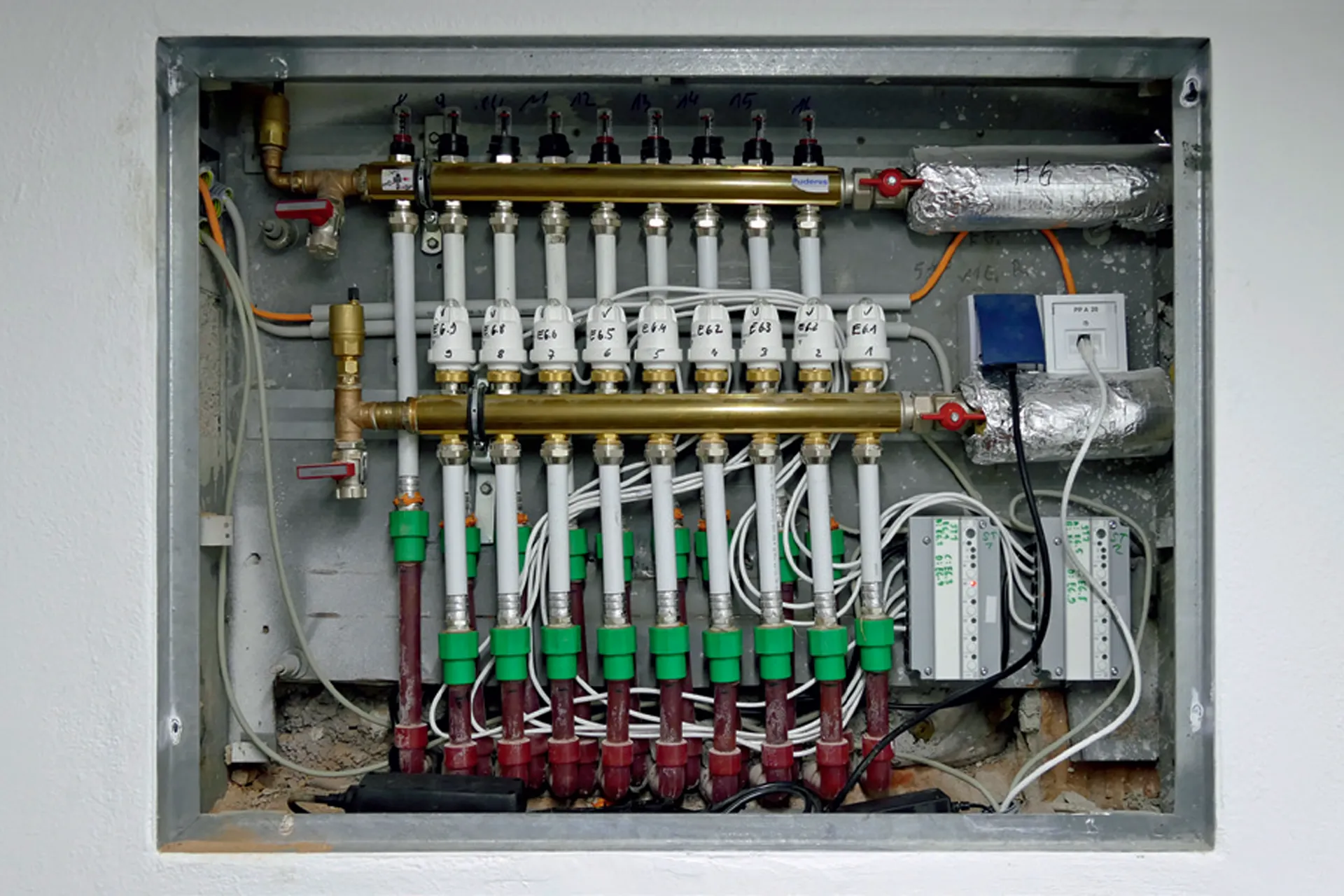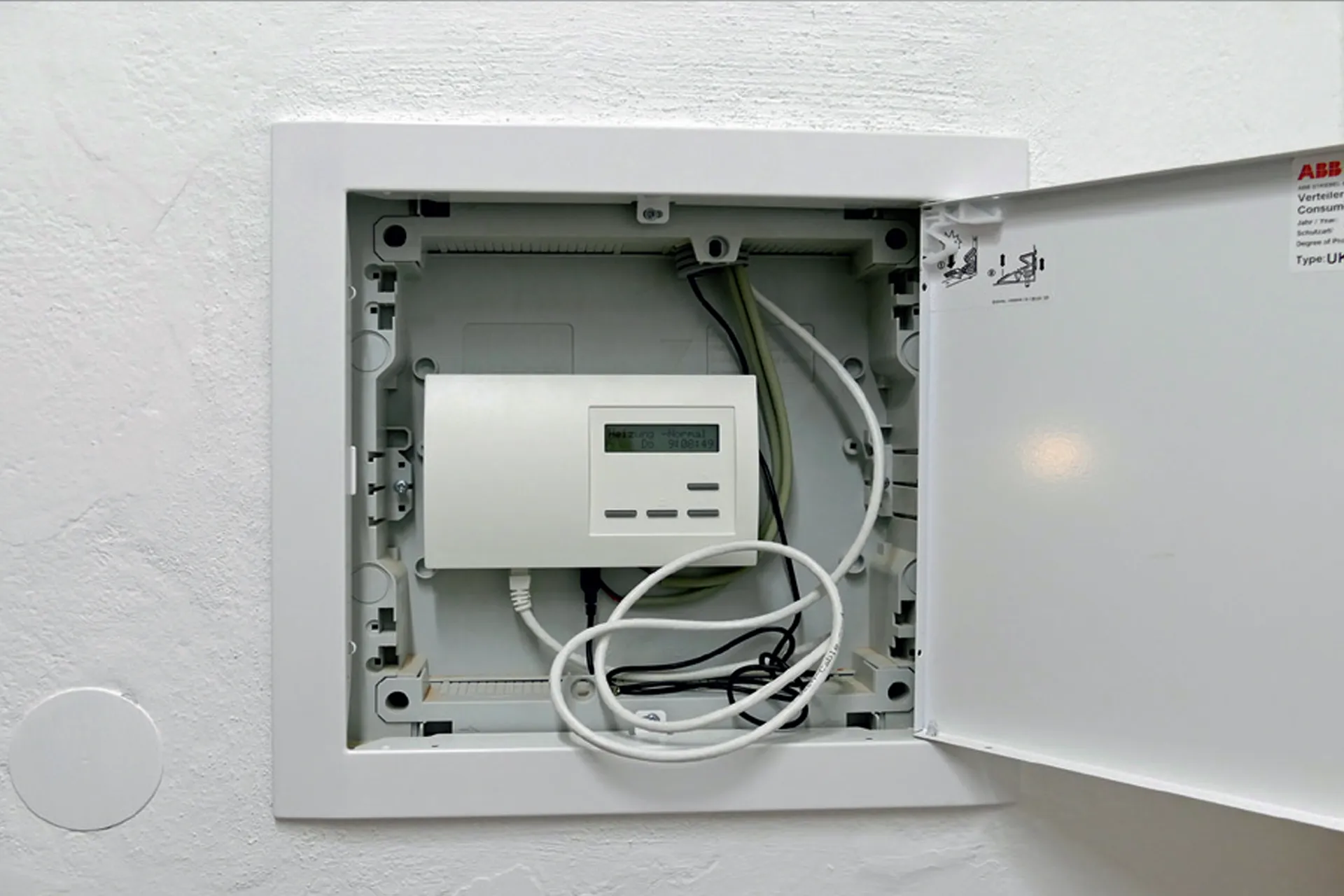Even floor heating systems that are more than 30 years old can be retrofitted to improve thermal comfort. In the Southern Bavarian Center for the Visually Impaired and Blind (SBZ), Unterschleißheim near Munich, individual room controls from Thermozyklus were retrofitted in the course of fire protection measures in the boarding and daycare buildings.
Warm water underfloor heating systems correspond to the ideal conception of many architects, builders and users: the comfort is high, barefoot walkers feel flattered by the warm floor, architects emphasize the architectural freedom in room design and hygienists praise the low dust turbulence and the dry warmth, which prevents the growth of house dust mites and mold. Since the investment costs of hot water floor heating systems are higher than those of radiator heating, in the past often saved on the control.
Typical of underfloor heating systems from the 1970s to 1990s is the collective control of the flow temperature for all rooms according to the outside temperature. Individual room controls tended to be the exception in new buildings until their mandatory introduction as part of the Energy Saving Ordinance (EnEV 2002). According to unconfirmed reports, around 90 % of all underfloor heating systems were controlled centrally according to the outside temperature until then.
During the construction of the Southern Bavarian Center for the Visually Impaired and Blind in Unterschleißheim in 1983, the architect, planner and client also decided predominantly in favor of the use of underfloor heating, especially in the twelve houses of the boarding and daycare groups. The controlled variable for the supply temperature of the underfloor heating was calculated from the 3-day average of the outside temperature.
At that time, manufacturers of underfloor heating systems relied on the high self-regulating effect and the balancing storage effect of the building. Controllable pumps and the hydraulic balancing that is mandatory today were of secondary importance, if at all. In the case of the SBZ property, a single outdoor sensor controlled the flow temperatures of eight houses - with the familiar disadvantages: too hot, too cold, fine adjustment of the room temperature via the window.
The SBZ in brief
A long tradition in the accompaniment and care of the visually impaired forms the basis for the Center for the Visually Impaired and Blind of Southern Bavaria (SBZ). In 1889, the Verein für Sehgeschädigtenerziehung e. V. opened the institution for the blind in Augsburg.
Today's SBZ emerged from this and has been based in Unterschleißheim since 1983. With our range of services based on experience and competence, we see it as our task to open up optimal development opportunities for blind as well as visually impaired children and adolescents for their later self-determined lives. Our goal is to activate and promote the abilities that exist in each individual. To this end, we develop a special, individual support concept for each child and work together with clinics, doctors in private practice, therapists, employment offices, the Association for the Blind and other institutions.
In this way, the children and adolescents entrusted to us are prepared for an independent and self-reliant life. Our center includes an elementary school, a middle school and a high school for blind and visually impaired children and adolescents. Attached to the center are an early intervention center, a school preparation center, a curative day care center, a curative home, the mobile special education service (MSD) as well as an integrative after-school care center and a crèche. Our work in the facility is characterized by networked action, which is achieved through close cooperation between the three pedagogical areas of school, home and specialized service. We create a harmonious coexistence with children, adolescents and staff, which is characterized by mutual respect.
Hildegard Mayr, Director SBZ
Fire protection measures associated with the installation of individual room controllers
The director of the SBZ, Mrs. Hildegard Mayr, took officially prescribed fire protection measures and the associated construction measures as an opportunity to also modernize the electrical installation.
In the course of this work, it also made sense to lay pipes for the individual room controls. In parallel, a retrofit of radiators in thermally particularly disadvantaged rooms also came into play; however, this was discarded again for cost reasons. Instead, the management of the SBZ decided to take stock of all the rooms using a thermal imaging camera to document the installation of the underfloor heating pipes. This inventory was necessary to ensure an exact allocation of the heating circuits at the manifold to the respective rooms and to determine the throttle values for the hydraulic balancing.
A call for tenders for the make ThermoZYKLUS as the lead make for the required technical properties resulted in the most economical bidder for the modernization measure choosing the manufacturer Thermozyklus, Gauting.
The client was convinced not only by the certified control accuracy of ± 0.15 K according to the European Eu-Cert certification, but also by the minimal structural and hydraulic intervention in the heating system and the central access of authorized persons via the PCi software to all relevant values, including the user history of the respective room. A total of twelve semi-detached houses, each with eight rooms, were retrofitted with individual room controllers. In each case, 18 individual room controllers are connected to a central unit, which is connected to the central network of the SBZ via Ethernet.
The installation of the electrothermal on/off actuators was carried out in the existing heating circuit manifolds, which are located on the ground floor and upper floor of each semi-detached house. The manual hydraulic balancing of the individual control zones is also carried out there on the basis of the subsequent hydraulic calculation. A temperature sensor is installed in the respective rooms without the possibility of intervention by the user.

Regulation more accurate and convenient than expected
With the gradual commissioning of the Thermozyklus individual room controllers, a new (heating) era has begun for Michael Setzer, deputy director of the SBZ: "After the adjustment phase, we hardly have to worry about the heating; there are virtually no more complaints, the rooms are neither too hot nor too cold. All special requests from the various residential groups are stored on the central control level."
Setzer is particularly impressed by the control characteristics of the valves, which are either "open" or "closed. Setzer comments: "This obviously allows the typical inertia of underfloor heating, but also disturbance variables such as open windows, to be regulated much faster and more precisely than with continuously regulating valves".
Setzer also sees the documentation of each individual control loop and the display on the PC as very helpful. "We can use the history of the room temperature curve and the control position of the valves to understand when windows were opened or closed and when internal loads, for example due to cooking, suddenly occurred." If complaints still come in at all, the reasons are easy to find out through the PC-based building monitoring program. The reprogramming of heating times or room temperatures is also done centrally via the authorized PCs; only one sensor is installed on site in the rooms.
"This central management of room temperatures has proven its worth," says Setzer. And further: "The system can even distinguish whether only the air in a room is cooled by an open window or also the walls".
And what about energy savings through individual room control? For Michael Setzer, representing the SBZ, the focus was on improving room comfort and monitoring via the PC. However, the energy savings of around 20 % predicted by Thermozyklus will be kept in mind.

Conclusion
The SBZ has taken necessary construction measures as an opportunity to retrofit the underfloor heating in twelve semi-detached houses, which is centrally controlled according to the outside temperature and is regarded as problematic, with individual room controls from Thermozyklus . The typical complaints - too warm, too cold - are now a thing of the past. The typical complaints - too warm, too cold - are now a thing of the past. Important for the operator is the central, PC-based monitoring of the actual and setpoint values in the 96 rooms tempered with underfloor heating. The operator sees the room-related documentation of the temperature history as a very helpful tool.
Published in: Modern Building Technology | Special Edition 2018 | Advertising Special Publication